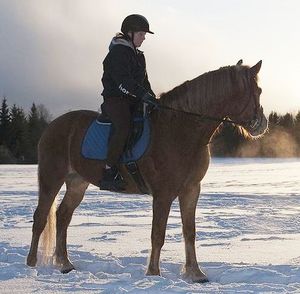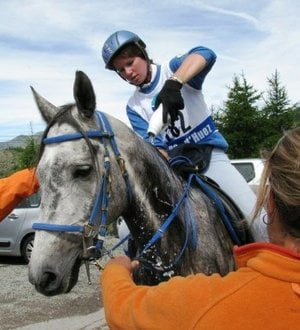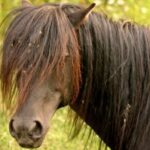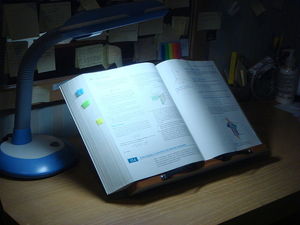The wintry outdoors beckons both horse lovers and their treasured mounts. What could be more refreshing and reinvigorating for an avid equestrian than a lovely horseback ride in the snow? What steps must equestrians take to stay safe on winter horseback rides?
Here are ten tips for horseback riding safely in the winter:
Safe Winter Horseback Riding: Prepare your horse for cold-weather work.
Most horses naturally grow heavy winter coats each year, particularly equines that are not blanketed for cold weather and spend considerable time outdoors in turnout. Although this extra furry covering keeps horses warmer outdoors, this can also cause equines in active work or training to become overheated easily during exertion. Many equestrians body-clip their horses for winter work.
In addition, horses that enjoy daily outdoor turnout may require extra hoof care. Snow and ice can easily build up under horses’ hooves, causing them to walk unevenly or even slip and fall. Some horses wear snow pads or have special winter horseshoes to add traction. Other equines go barefoot in winter, particularly if they do not work much in cold-weather months.
Some equestrians use extra-grip hoof boots for outdoor riding in the winter.
Safe Winter Horseback Riding: Examine your equestrian equipment before cold-weather riding.
Cold weather can wreak havoc on horseback riding tack, saddles and other equipment. Winter moisture, as well as repeated freezing and thawing, may harm leather and metal components. Smart equestrians check their tack frequently and clean and condition their equipment regularly. Well-maintained tack is less likely to break at an inopportune moment – or at all.
Safe Winter Horseback Riding: Dress appropriately for cold-weather riding.
Winter equestrian safety includes proper attire. Those heading outdoors on horseback in cold weather ought to dress in layers, choosing warm, waterproof clothing. Sturdy, moisture-wicking layers of winter apparel are ideal.
Cozy hats and durable gloves (with gripping palms) are well-suited to winter equestrian activities. Long scarves and dangly accessories, of course, are inappropriate and unsafe for horseback riding in any season.
Safe Winter Horseback Riding: Select the necessary safety equipment for cold-weather riding.
Sturdy winter riding boots (with traction soles) and safety approved horseback riding helmets are essentials for cold-weather rides and even on-the-ground horse handling.
Safe Winter Horseback Riding: Consider your horse’s physical conditioning for cold-weather riding.
A horse’s work or training schedule may become somewhat altered or abbreviated in the winter months, when barn chores are increased by cold weather. Smart equestrians will carefully gauge the physical condition of their horses in planning winter workouts or horseback rides.
An extra furry and possibly out-of-shape horse may not be ready for a full-fledged schooling session, although a long walk or gentle jog might do him and his rider plenty of good.
Safe Winter Horseback Riding: School your horse sufficiently before heading outdoors for cold-weather riding.
Horses tend to enjoy cold weather and snow. In fact, equines may experience increased exuberance (at least for a few moments at a time) during the winter. A savvy equestrian will school a horse in an enclosed arena or round pen for at least a few minutes, either on the longe line or under saddle), before heading out into the snow.
This exercise will offer both horse and rider a chance to settle in together in a safer, more controlled situation.
Safe Winter Horseback Riding: Keep good company for cold-weather riding.
For safety’s sake, as well as increased enjoyment, wise equestrian team up with other competent horseback riders for outdoor winter riding. Ideally, these trail buddies have reliable, well-trained horses as well.
Safe Winter Horseback Riding: Choose a safe route for cold-weather riding.
Snow riding can be great fun, if equestrians select safe trails and horseback riding routes. Even if groomed bridle paths are not available, smart horseback riders will choose familiar fields and paths. By doing so, riders and horses are less likely to be surprised by unseen hazards, such as fallen logs or unexpected pits in the ground.
Icy ponds and puddles should be avoided, as ice may crack under a horse’s weight. Paved roads and sidewalks are also areas for increased caution, since these tend to be quite slippery under wintry conditions.
If equestrians find they must cross very slippery areas, it’s a good idea to dismount and lead horses past the treacherous terrain.
Safe Winter Horseback Riding: Be smart for cold-weather riding.
Careful equestrians stay in tune with their horses, especially during harsher weather, watching for signs of equine overexertion, breathing difficulties, loss of solid footing or other potential concerns.
Certainly, jumping should be reserved for warmer months, unless equestrians have access to groomed arenas.
Safe Winter Horseback Riding: Add extra cool-down for your horse for cold-weather riding.
Active horses often require calming cool-downs after strenuous workouts or schooling. During cold-weather months, this may be even more necessary than usual. If a horse is panting with heaving sides and flaring nostrils after exercising, then he or she may need an extra long cooling out period before returning to the stall or turnout.
Many equestrians cover their equines with cozy horse coolers (usually made of fleece, terrycloth or wool) to prevent chills until their perspiration dries.
By making a few practical preparations and taking some simple precautions, horse lovers can minimize their enjoyment and maximize safety during outdoor equestrian activities in cold-weather months.







